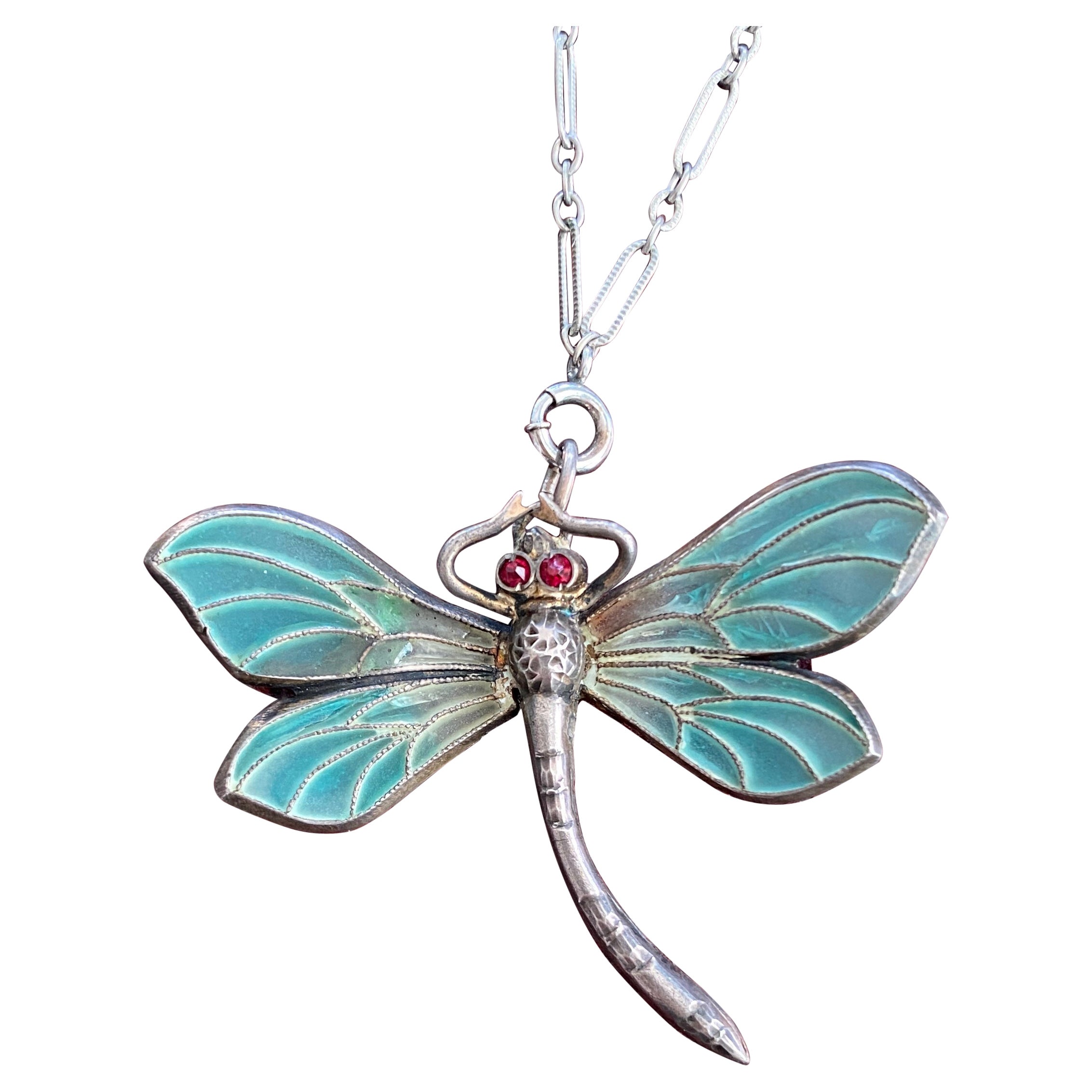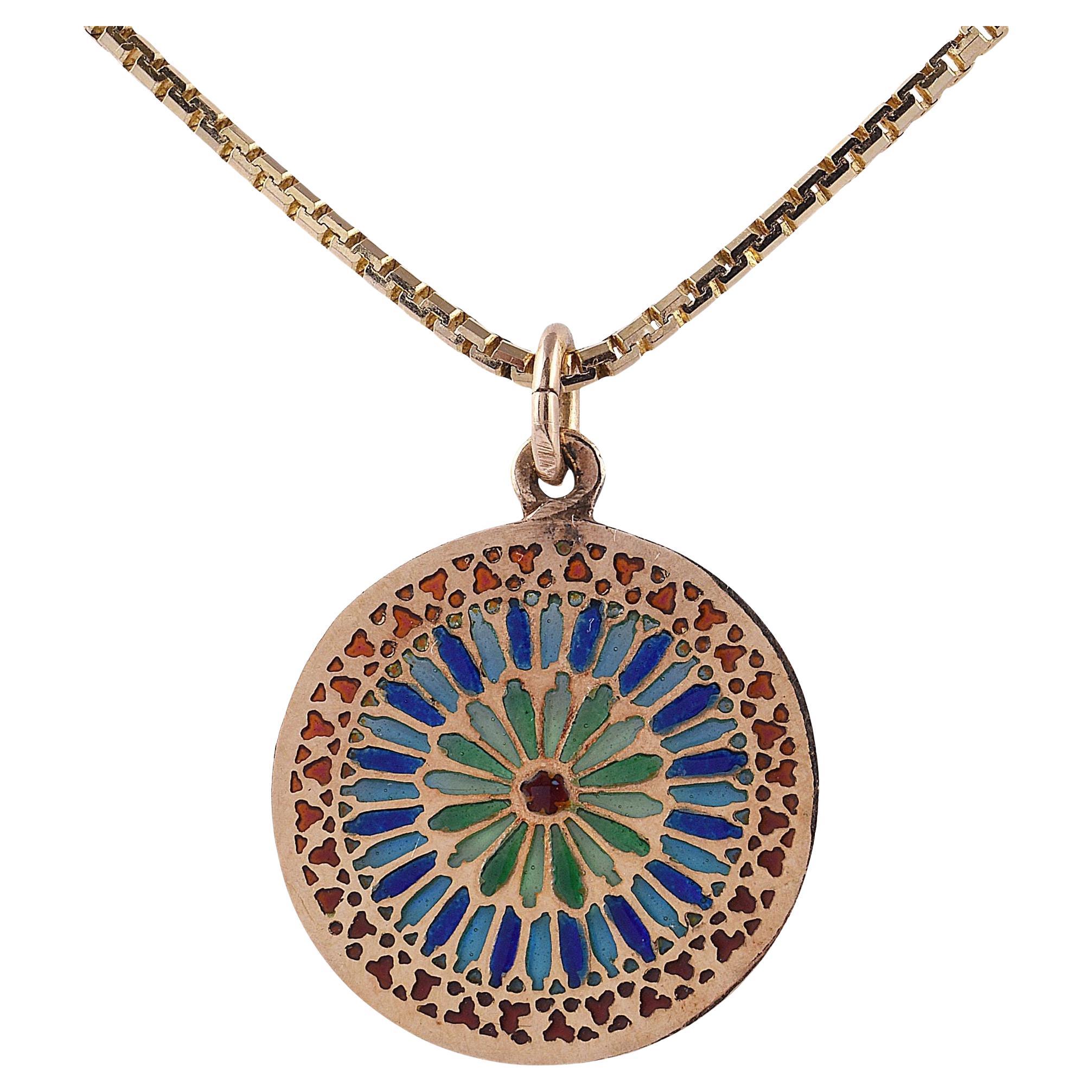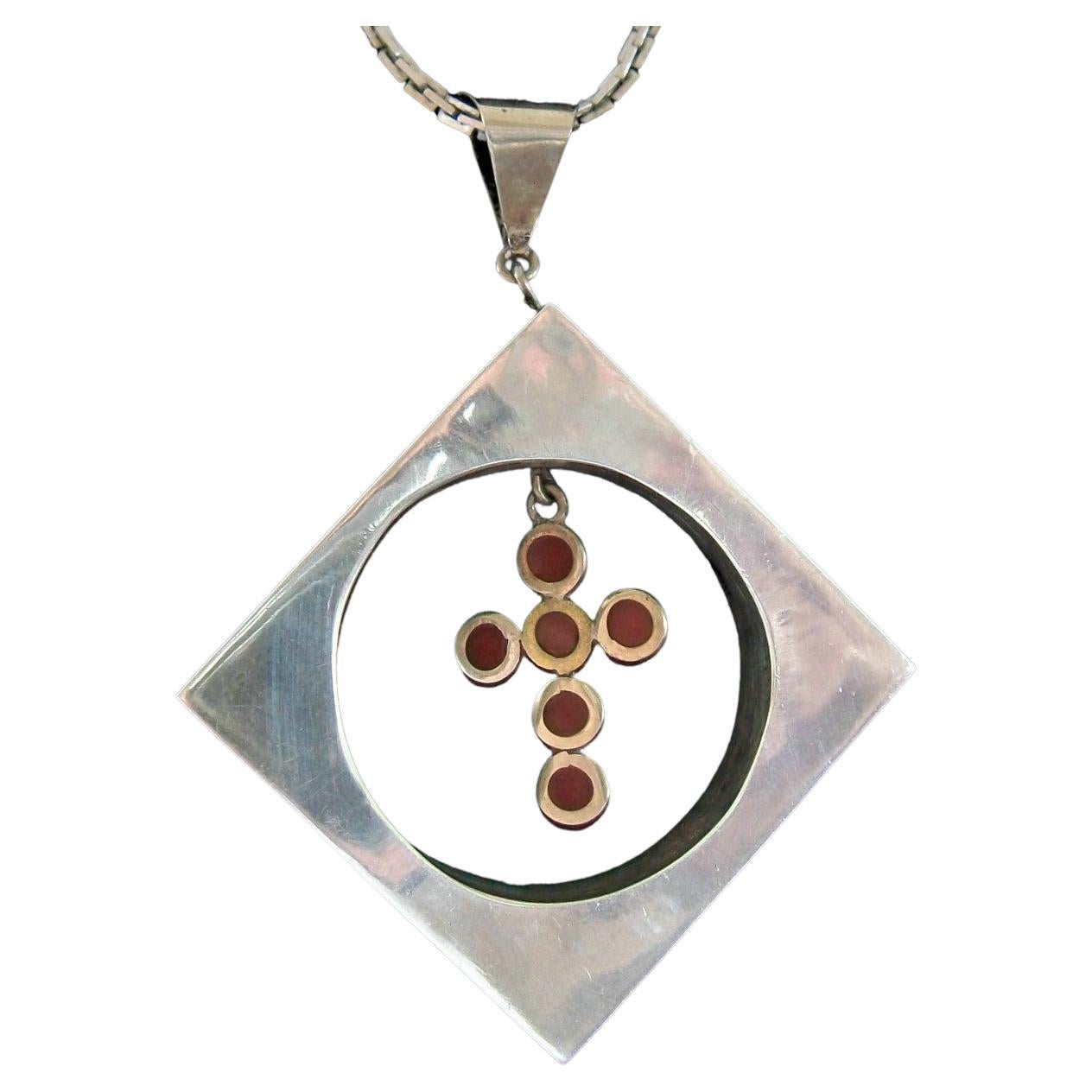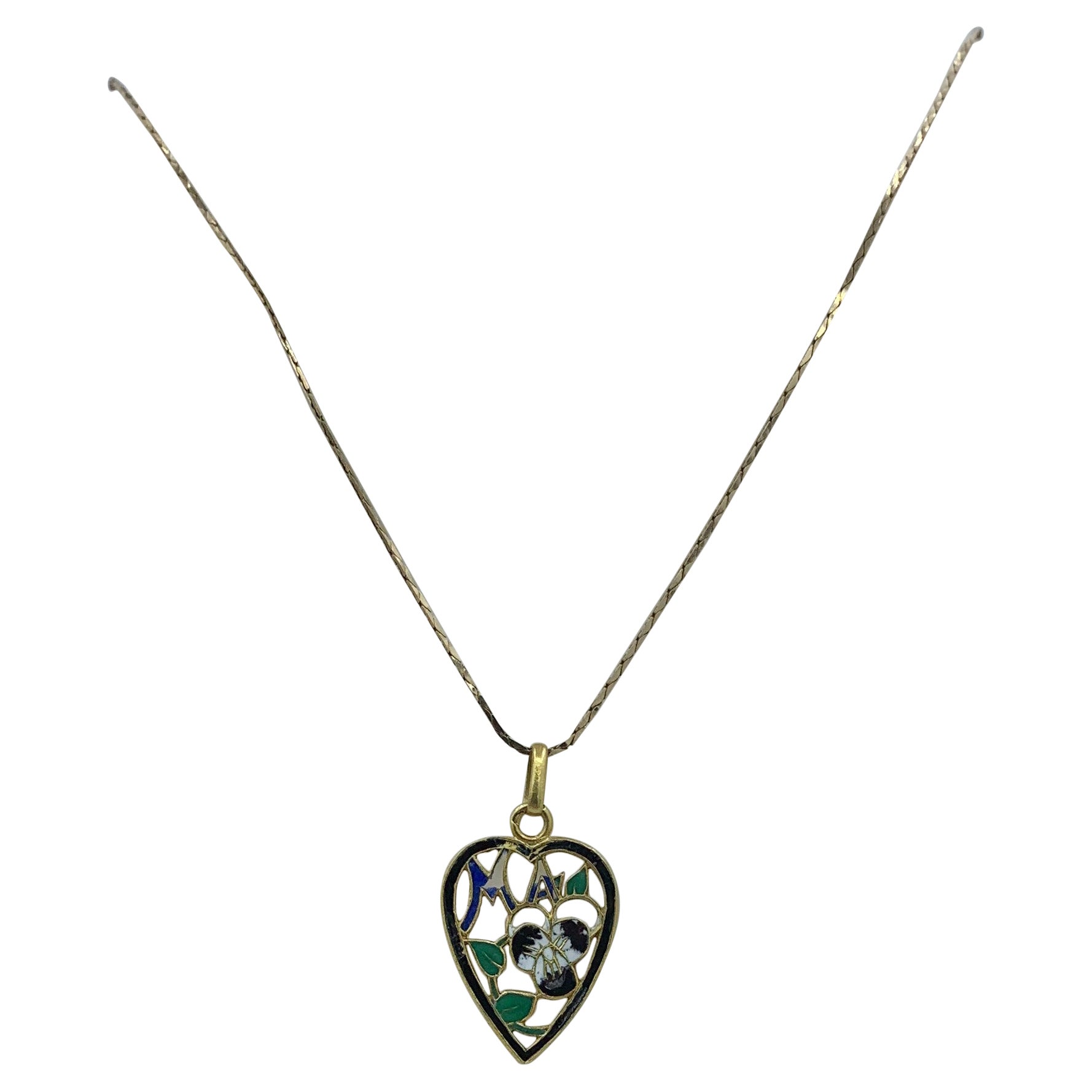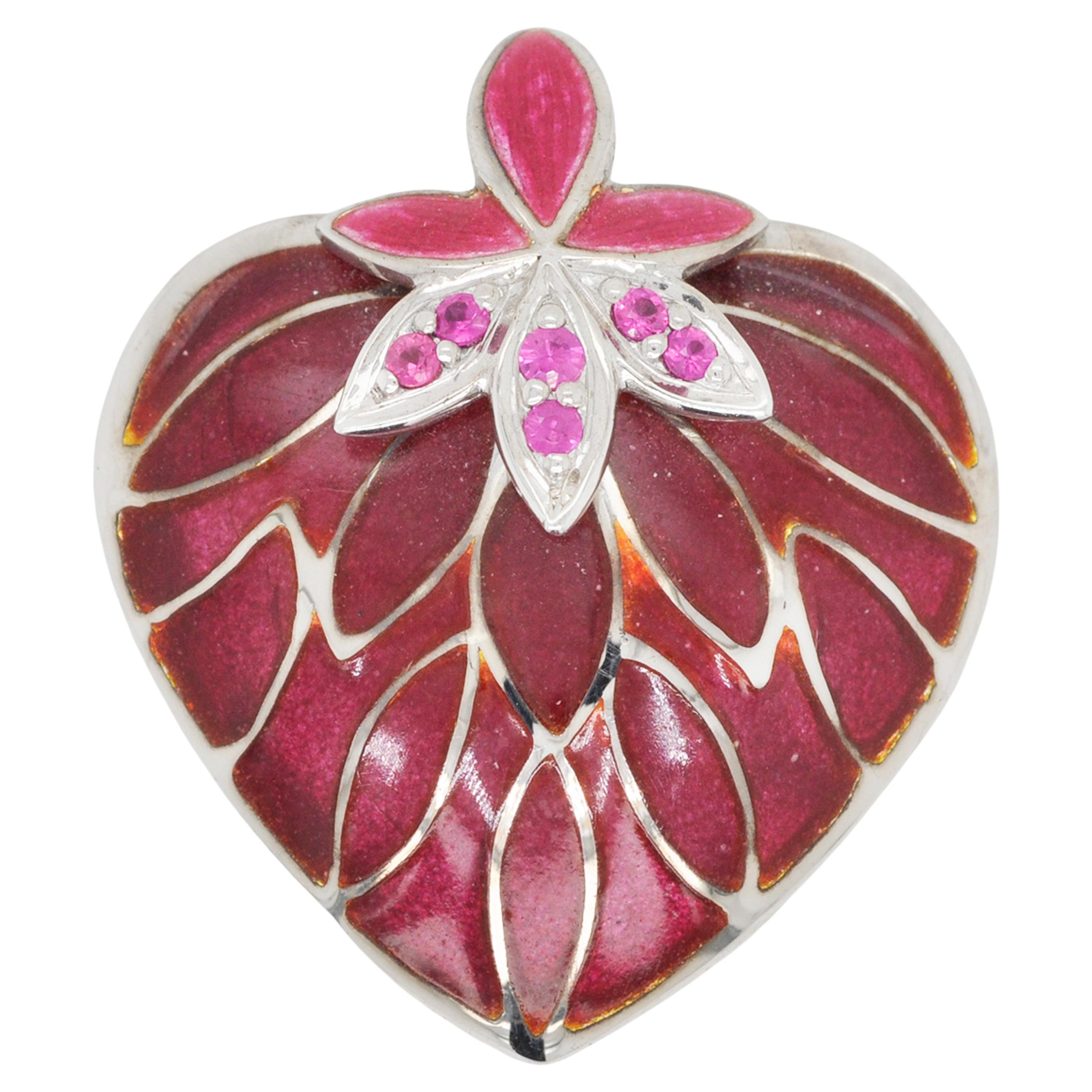Items Similar to Meyle & Mayer 1910 Art Nouveau Gilt Silver Pendant With Enamel & Plique Au Jour
Want more images or videos?
Request additional images or videos from the seller
1 of 10
Meyle & Mayer 1910 Art Nouveau Gilt Silver Pendant With Enamel & Plique Au Jour
About the Item
An art nouveau slide mirror pendant designed by Meyle & Mayer.
Fabulous piece, created in Pforzheim Germany by Meyle & Mayer during the art nouveau period, between the 1900 and 1910. This rare pendant has been designed as a slider mirror, crafted in solid .800/.999 silver with 24 karats gilt finish. Embellished with applications of multicolor hot enamel and parts treated with plique au jour translucent gray and green glass enamel.
The main image shows us an allegory to music, with a richly dressed and decorated muse who is playing a kind of stringed musical instrument, more like a lute.
Gemstones: Mount in bezel settings, with 2 matching pear cabochon cut, carved from natural translucent green chrysoprase, with an estimate weight of 2.25 carats.
Sapphires: Mount in flush settings, with 4 round cabochon cut of vivid blue sapphires, .08 carats.
Birthstone: Chrysoprase for the month of May.
Weight: 47.40 Grams, (30.38 Dwt).
Measurements: 84 mm by 42 mm (3.31 x 1.65 Inches).
Hallmarks: Stamped with the German export mark for the assay of the .800 silver inside a rectangle cartouche.
Meyle & Mayer
The company was founded in 1887 in Pforzheim, Germany by Gustave Mayle and Julius Mayer. They were two of the greatest Jugendstil / Art Nouveau masters in Germany, who produced rich and astounding jewelery. The Meyle & Mayer manufacture was destroyed during WW2 (in 1945) and never operated again.
Allegory to music in art
Musical allegory, has come to mean not merely the representation. of concrete objects or actions but the representation of fairly complex. abstract principles, such as theological ideas. Allegory in art is when the subject of the artwork, or the various elements that form the composition, is used to symbolize a deeper moral or spiritual meaning such as life, death, love, virtue, justice etc.
Art Nouveau History
Or so called the new art jewelry was created in Europe between about 1895 and 1915, coming on the heels of the “overwrought” designs of the Victorian era (which ended with Queen Victoria's death in 1901) and creating a striking contrast to the mainstream Edwardian designs of that time. While jewelry with a similar aesthetic was being made in other countries during the same time period--for example, Jugendstil in Germany and Austria--true Art Nouveau jewelry is decidedly extended in France. It was a short-lived period in jewelry design, lasting only about 15 years, because of the onset of World War I and because the pieces were so over-the-top that people quickly lost interest in them. Characterised by lavish and organic ornamentation, the Art Nouveau movement blossomed in Vienna at the turn of the 20th Century, with influential Austrians architects Otto Wagner and Adolf Loos making significant architectural contributions that helped shape the city's skyline as we see it today. Rene Lalique, was the most celebrated art nouveau designer, championed jewelry designer.
Plique à jour
Came from the French is "letting in daylight". Is a very difficult vitreous enamelling technique where the enamel is applied in cells, similar to cloisonné, but with no backing in the final product, so light can shine through the transparent or translucent enamel. It is in effect a miniature version of stained-glass and is considered very challenging technically: high time consumption (up to 4 months per item), with a high failure rate. The technique is similar to that of cloisonné, but using a temporary backing that after firing is dissolved by acid or rubbed away. A different technique relies solely on surface tension, for smaller areas. In Japan the technique is known as shotai-jippo (shotai shippo), and is found from the 19th century on.
Literature: cf. Jugendstil-Schmuck // Art Nouveau Jewellery from Pforzheim, Fritz Falk, 2009, Pp 258-271 for similars sliding mirror illustrated. Beatriz Chadour-Sampson & Sonya Newell-Smith, Tadema Gallery London Jewellery from the 1860s to 1960s, Arnoldsche Art Publishers, Stuttgart 2021, p. 24 for a similar technique of plique au jour illustrated.
Collateral: It is accompanied by a presentation jewelry box.
Condition: The overall condition of this piece is excellent. Beside the little normal wear, there is no damage to the silver or the enamel. All gemstones are secured in the settings. This piece has been carefully inspected to guarantee the condition and authenticity.
INVENTORY REF: P062423MONM/1.215
- Creator:Meyle & Mayer Pforzheim
- Metal:
- Stone:
- Stone Cut:
- Weight:47.4 g
- Dimensions:Width: 1.65 in (41.91 mm)Length: 3.31 in (84.08 mm)
- Style:
- Place of Origin:
- Period:
- Date of Manufacture:1910
- Condition:Wear consistent with age and use. The overall condition of this piece is excellent. Beside the little normal wear, there is no damage to the silver or the enamel. All gemstones are secured in the settings. This piece has been carefully inspected to guarantee the condition and authent.
- Seller Location:Miami, FL
- Reference Number:
About the Seller
4.9
Recognized Seller
These prestigious sellers are industry leaders and represent the highest echelon for item quality and design.
Platinum Seller
These expertly vetted sellers are 1stDibs' most experienced sellers and are rated highest by our customers.
Established in 1995
1stDibs seller since 2022
420 sales on 1stDibs
Typical response time: <1 hour
- ShippingRetrieving quote...Ships From: Miami, FL
- Return PolicyA return for this item may be initiated within 1 day of delivery.
More From This SellerView All
- Meyle & Mayer 1895 German Art Nouveau Enameled Brooch with Diana in 18Kt GoldLocated in Miami, FLAn etruscan revival enameled brooch designed by Meyle & Mayer. Magnificent antique piece, created in Pforzheim Germany by the jewelry maker's Me...Category
Antique 1890s German Art Nouveau Dangle Earrings
Materials18k Gold, Yellow Gold, Silver, Enamel, Gold
- Meyle & Mayer 1900 Art Nouveau Enamel Stick Pin In 18Kt Yellow GoldLocated in Miami, FLAn art nouveau enamel pin by Meyle & Mayer. Fabulous antique piece created in the city of Pforzheim in Germany by the Meyle & Mayer company du...Category
Antique Early 1900s German Art Nouveau Brooches
MaterialsGold, 18k Gold, Yellow Gold, Enamel
- Art Nouveau 1890 Plique a Jour Pendant Brooch in 18kt Gold Diamonds Pearls RubyLocated in Miami, FLArt Nouveau Plique à jour pendant brooch. A exceptional piece, created during the Art Nouveau period, back in the 1890. Surely It was crafted in Austria or Germany with the difficul...Category
Antique 1890s Austrian Art Nouveau Pendant Necklaces
MaterialsDiamond, White Diamond, Pearl, Natural Pearl, Ruby, Gold, 18k Gold, Yell...
- Meyle & Mayer 1900 Art Nouveau Guilloche Enamel Stick Pin In 18Kt Yellow GoldLocated in Miami, FLAn art nouveau enamel pin by Meyle & Mayer. Fabulous antique piece created in the city of Pforzheim in Germany by the Meyle & Mayer company du...Category
Antique 19th Century German Art Nouveau Brooches
MaterialsGold, 18k Gold, Yellow Gold, Enamel
- Masriera Art Nouveau Plique À Jour Enamel Ring in 18Kt Yellow Gold with DiamondsBy MasrieraLocated in Miami, FLAn art nouveau enameled ring designed by Masriera. Colorful piece, created in Barcelona Spain by the jewelry designer Gloria Masriera for Masriera. This beautiful ring has been crafted with art nouveau revival patterns in solid rich yellow gold of 18 karats with high polished finish. The ring has been created with organic flowers design and embellished with application of translucent multicolor enamels in the plique a jour technique. Diamonds: Mount in a millegrain setting, with 31 round brilliant cut diamonds, 0.62 carats, white colorless E color, VS-1 clarity. Weight: 9.35 Grams, (5.99 Dwt). Size: 6.75 sizeable. Measurements: 22 mm by 15 mm (0.87 x 0.59 Inches). Hallmarks: Stamped with the maker's mark, the gold assay mark, the serial numbers and signed in full, "MASRIERA Y CARRERA...Category
Late 20th Century Spanish Art Nouveau Band Rings
MaterialsDiamond, White Diamond, Gold, 18k Gold, Yellow Gold, Enamel
- Austrian 1915 Art Nouveau Egyptian Revival Plique à Jour Winged Scarab BroochLocated in Miami, FLAustrian Egyptian revival Plique à Jour winged Scarab brooch An exceptional elongated brooch, created in Austria during the art nouveau period, back in the 1915. This magnifique piece has been carefully crafted with the egyptian revival style, in solid .900/.999 silver with brushed finish. The wings are accented with applications of the difficult technique of Plique à Jour in translucent yellow-green and bluish-gray enamels. Fitted at the reverse with a hinged horizontal bar with a security lock. The figure represent the Egyptian sacred scarab with open feathers wings, of the god Khepri. Quartz Stones: Mount in bezel settings, with 2 round cut of blue quartz. Opal: Mount in a bezel setting, with 1 oval cabochon cut of a natural opal of about 2.75 carats. Weight: 17.95 Grams, (11.50 Dwt). Measurements: 108 mm by 26 mm (4.25 x 1.02 Inches). Hallmarks: Stamped with the maker's mark inside a circle, the mark for the assay of the silver and signed, "FL DEPOSE STERLING .900". Egyptian Winged Scarab This kind of beetle was highly symbolic to ancient Egyptians, it represented rebirth and renewal. They believed that the sun was pushed across the sky every day by a giant scarab, the god Khepri. In real life, the scarab beetle lays its eggs in a ball of dung and rolls the ball ahead of it wherever it goes. Originated in Ancient Egypt. A scarab is shaped like a dung beetle. There is a head, wing case, and legs. It is sometimes rounded and sometimes flat. The scarab was associated with the god Khepri who was the god or rebirth, creation, and the sun. Dung beetles were the earthly personification of Khepri as they would lay their eggs in balls of dung and then roll the dung balls all around until the eggs hatched. Early hieroglyphics depict Khepri as a scarab holding up the sun. There were hundreds of memorial scarabs created to memorialize Amenhotep III’s deeds. These included the bull hunt scarab which symbolizes strength and victory over chaos. Later, around 2000 BCE the scarab was used in jewelry and as seals. The amulets were worn as protection against the dangers of this world and the afterlife. The scarab represented the sun god Ra that rolled across the sky each day. Between the 16th and 11th- century heart scarab...Category
Vintage 1910s Austrian Art Nouveau Brooches
MaterialsOpal, Quartz, Silver, Enamel
You May Also Like
- Art Nouveau Plique-a-Jour Dragonfly Silver Pendant NecklaceLocated in Scotts Valley, CADetails: Plique-a-Jour Art Nouveau dragonfly pendant necklace in sterling silver in beautiful shades of blue and green with little bright red eyes—possibly ruby or maybe paste, not t...Category
Early 20th Century European Art Nouveau Pendant Necklaces
MaterialsSilver
- Art Nouveau Hydrangea Plique a Jour PendantLocated in New York, NYArt Nouveau Hydrangea Plique a Jour Pendant set in silver with hand painted hard enamel florals and plique a jour leaves. Realistically modeled silver branch with a enamel bloom belo...Category
Antique Early 1900s German Art Nouveau Pendant Necklaces
MaterialsSterling Silver
- Plique A Jour Enamel Pendant NecklaceLocated in Solvang, CAVintage Plique A Jour enamel pendant necklace. This beautiful round pendant is crafted in 18 karat gold with plique a jour enamel in an intricate mandala style pattern. The vintage e...Category
Mid-20th Century Pendant Necklaces
Materials18k Gold, Yellow Gold, Enamel
- Modernist Silver Enamel Pendant with Plique-à-jour Cross, Mexico, circa 1970sLocated in Chatham, CAModernist sterling silver and mixed metals (copper and brass) enameled pendant with plique-à-jour enamel cross - each outside panel with a unique design - hollow construction - large...Category
Late 20th Century Mexican Modernist Pendant Necklaces
MaterialsSterling Silver, Enamel
- Art Nouveau Pansy Heart Plique-a-jour Enamel Flower Pendant 14 Karat GoldLocated in New York, NYTHIS IS A LOVELY ART NOUVEAU PENDANT NECKLACE WITH A BEAUTIFUL LAVENDER, CREAM, GREEN AND BLUE PLIQUE-A-JOUR ENAMEL PANSY FLOWER AND LEAVES IN THE CENTER OF A HEART. THE FLOWERS AN...Category
20th Century Unknown Art Nouveau Pendant Necklaces
MaterialsGold, 14k Gold, Yellow Gold, Enamel
- Sterling Silver Apple Red Heart Plique-à-Jour Enamel Pendant NecklaceBy Vaibhav DhaddaLocated in Jaipur, RajasthanThis stunning Sterling Silver Apple Red Heart pendant with deep red plique-à-jour enamelling is delicately detailed with lab created pink tourmaline ...Category
21st Century and Contemporary Indian Contemporary Pendant Necklaces
MaterialsEnamel, Sterling Silver
Recently Viewed
View AllMore Ways To Browse
Grays Antique Jewellery London
Antique Silver Jewelery
Music Box Necklace
Rectangle Gilt Mirror
Niello Locket
Pixiu Jade
Pomellato Garnet Diamonds Necklace
Precolumbian Gold
Qilin Necklace
Roberto Coin Initial
Saint Esprit Dove
Shipwreck Coin Pendants
Snowflake Locket
Snuff Locket
Tiffany 09 Carat Diamond
Tiffany And Co Bean Pendant Necklace
Tiffany And Co Bean Pendant
Turquoise Handcarved
